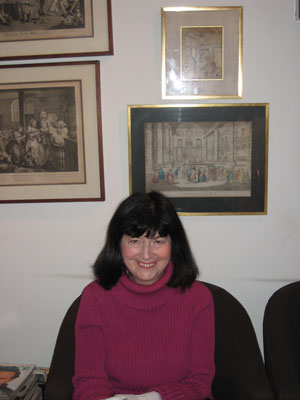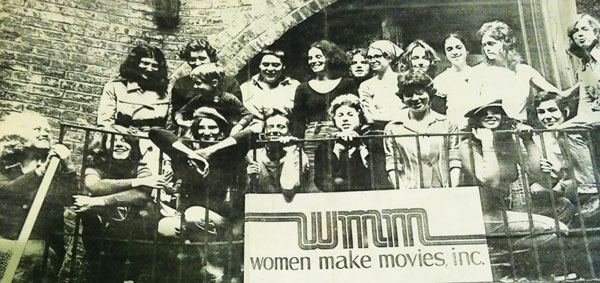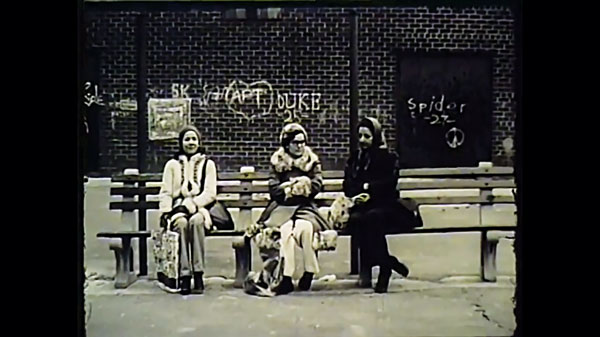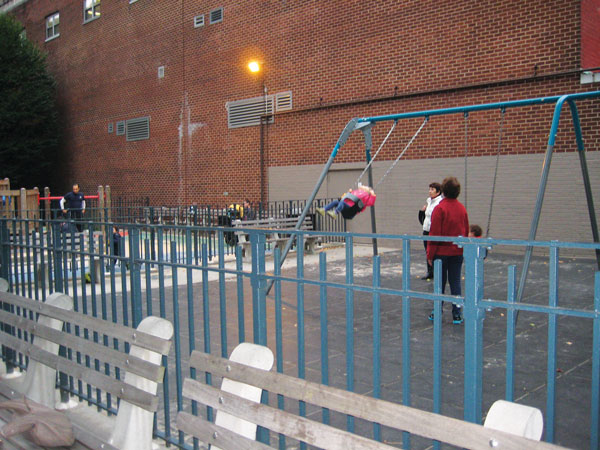BY DUSICA SUE MALESEVIC | Serendipity played a starring role in the making of 1973’s “Domestic Tranquility,” a short film set in Chelsea’s Penn South that now gives a glimpse into the neighborhood’s past.
“It was really a wonderful accident,” the filmmaker Harriet Kriegel told Chelsea Now during a recent visit to her Penn South apartment and a walk to where many of the film’s scenes were shot.
It was the fall of 1972 and Kriegel was finishing up her master’s in theatre at Hunter College when she saw an ad in a local paper calling for women interested in learning how to make films. She debated with herself about going, but curiosity won out. She got the kids bathed, made sure they had dinner and left her two young sons with her husband.
In the basement of St. Columba (at 343 W. 25th St., a few blocks away from her apartment), Kriegel met the organizers of the gathering. Women Make Movies, which was founded that year and still facilitates movies by and for women, had received $9,000 in funding from the New York State Council on the Arts.
“Women’s stories did not exist much on film at all,” said co-founder Ariel Dougherty, who also lived in Chelsea at that time, in a phone interview.

“Domestic Tranquility” director Harriet Kriegel, in the Penn South apartment she’s lived in since 1970.
Dougherty asked Kriegel what she wanted to make a movie about. Although Kriegel had an interest in drama, acting and the theatre, this question had never been posed to her before.
“You kind of have these fantasies, one day you’ll make ‘Gone With The Wind,’ ”she recalled. “I was stunned.”
As a writer, Kriegel was used to dealing with words. Her master’s thesis would become the anthology “Women in Drama,” which she would edit, and she had written for The Nation and Commonweal.
“But this was a whole new concept,” she said. “I had to think about how to express my ideas visually.”
At the time, Kriegel was interested in the women’s movement and art, but was also contemplating a picture she considered very special. While living in the Netherlands in the sixties, she had bought a watercolor by Amsterdam-born Christina Chalon (1748-1808).
Kriegel got up from the red couch in her living room and showed Chelsea Now the watercolor in which the domestic scene, of a woman bent over a bucket washing something, is not idealized.
“I love the Dutch Masters,” said Kriegel, whose living room is filled with art and art books. “All of the Dutch Masters had these wonderful domestic scenes, these lovely women and they’re very serene. But she’s really working. Men don’t paint that.”
She imagined the life of Chalon, who came from a family of Dutch artists and who ended up committing suicide, according to the man who sold her the picture. During the sixties, seminal books such as Betty Friedan’s “The Feminine Mystique” and Doris Lessing’s “The Golden Notebook” were published, and Kriegel was thinking about feminism and being a housewife.
It was a lot to express in the almost seven-minute film and Kriegel wasn’t sure how she going to going to do it visually. She wrote an outline and dialogue, although much of it wasn’t used — the sound was overlaid after.
Instruction from Women Made Movies was wonderful, she said. “I couldn’t even take a good snapshot let alone use a film camera,” she said.

A 1974 gathering of Women Make Movies members, at 19th St. & Eighth Ave. The organization still facilitates movies by and for women.
Dougherty said the women were taught close-ups, pans and long shots. Kriegel learned how to load film, shoot with a Bolex 16mm camera and use a tripod. The women in the film gave their time and Kriegel remembers their patience as one time she struggled to load the camera.
“It was very much a neighborhood thing, very much a Chelsea thing, mostly Penn South,” said Kriegel. “All the women lived in the neighborhood, almost everybody lived in the co-op with some exceptions.”
After the meeting at the church in the fall of 1972, she started shooting and finished sometime in the spring of 1973. The film was completed after an arduous editing process.
“The interesting thing for me was the editing process, which took forever, never would have believed it,” she said. “It demanded so much time if you wanted to do a careful job.”
In addition to the editing, it was challenging to accommodate the schedule of the women who were in the movie, as some had children.
“In order to make this work, I had to plan very carefully ahead of time,” said Kriegel.
The film opens with Chalon’s watercolor, which soon the main character, Rachel (Sandra Kazan), will dust. She then vacuums, which bothers her husband, a writer who is working on his typewriter. The viewer never sees his face.
While looking in the closet, she comes across artwork, which may be hers. Her husband asks her to take the kids, who are watching television and painting, outside so he can concentrate (two of the children are played by Bruce and Mark Kriegel).

Penn South’s Sandbox Park, as it was in 1972.
She and the three kids go to the playground in Penn South, where they play in a sandbox, while she sits on a bench with other mothers. One woman embroiders, another is reading a magazine with an article title, “The Spotlight’s on Spot Reducing…Try These for Size,” while the main character takes out an art book and studies a painting of a nude woman reclining. The other mothers comment on her weight.
Cut to a scene where two men are making kissing noises and saying lewd comments to Rachel. Then we are back in the apartment, the women are gathered to eat banana bread and drink coffee. For our main character, she is there and not there, the conversation sounding like a fast-forwarded recording.
The last scene is Rachel painting, one tear falls, and the viewer hears her daughter asking for some peanut butter.
The issues addressed — street harassment, body image, being a working mother and deferred dreams — are ones that women still grapple with today.
“It’s striking that the conflicts and our concerns have not changed,” said Kriegel, who said she was lucky and had an extremely supportive husband.
Kriegel grew up in Washington Heights. After getting married in 1957, she and her husband moved to Chelsea and have not left. They moved into the first Penn South building in May of 1962 and have lived in their current apartment since 1970.

Sandbox Park has changed since serving as a location for “Domestic Tranquility.” The wall with graffiti is now clean, and the benches the mothers sat on have been moved in front of the swings.
Kriegel said Chelsea has changed enormously with the surrounding area becoming very prosperous with an art scene, Chelsea Piers, the High Line and restaurants galore.
“When we first moved here, you couldn’t find a decent restaurant, let alone a coffee shop,” she said. “You wanted to find something, you had to go down to the Village.”
The playground in the film, now Sandbox Park, has also changed. Where once was a wall with graffiti is now clean, with a swing set in front of it. The benches the mothers sat on in the film have been moved in front of the swings. There is now a colorful large jungle gym with bridges and slides. There is still a sandbox.
The film was shown at Penn South in the summer of 1973. It was chosen that year to be part of MOMA’s New Director Series. The 16mm film then languished in Kriegel’s closet until 2012, when the New School hosted a screening of early Women Make Movies films, including “Domestic Tranquility.” Kriegel dug it out of the closet and repaired the film for the screening.
“When I first saw it, I was super critical,” she said. “When I saw it recently, I said, ‘that’s not bad.’ ”
For more information on Women Make Movies, visit wmm.com.


































